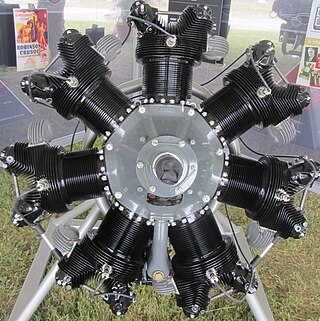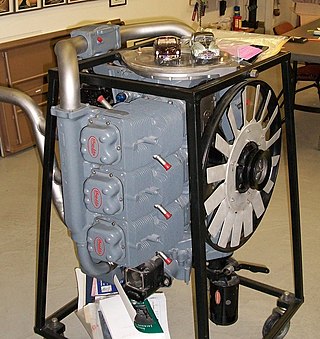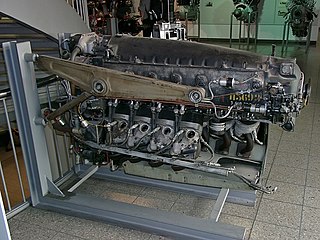
The BMW 132 was a nine-cylinder radial aircraft engine produced by BMW starting in 1933.

The Continental O-170 engine is the collective military designation for a family of small aircraft engines, known under the company designation of A50, A65, A75 and A80. The line was designed and built by Continental Motors commencing in the 1940s. It was employed as the powerplant for civil and military light aircraft.

The Lycoming XR-7755 was the largest piston aircraft engine ever built in the United States, with 36 cylinders totaling about 7,750 in3 (127 L) of displacement and a power output of 5,000 horsepower (3,700 kilowatts). It was originally intended to be used in the "European bomber" that eventually emerged as the Convair B-36. Only two examples were built before the project was terminated in 1946.

The Warner Scarab is an American seven-cylinder radial aircraft engine, that was manufactured by the Warner Aircraft Corporation of Detroit, Michigan in 1928 through to the early 1940s. In military service the engine was designated R-420.

The Continental R-670 was a seven-cylinder four-stroke radial aircraft engine produced by Continental displacing 668 cubic inches and a dry weight of 465 lb (211 kg). Horsepower varied from 210 to 240 at 2,200 rpm. The engine was the successor to Continental's first radial engine, the 170 hp Continental A-70. This engine was used on many aircraft in the 1930s and 1940s. The R-670 was widely used in the PT-17 Stearman primary training aircraft of the U.S. military.

The Franklin O-335 was an American air-cooled aircraft engine of the 1940s. The engine was of six-cylinder, horizontally-opposed layout and displaced 335 cu in (5.5 L). The power output of later variants was 225 hp (168 kW).
The Franklin O-175 was an American air-cooled aircraft engine of the 1940s. The engine was of horizontally-opposed four-cylinder and displaced 175 cu in (2.9 L). The power output was nominally 80 hp (60 kW). A later variant was designated O-180, despite sharing the same displacement.

The Siemens-Halske Sh 14 was a seven-cylinder air-cooled radial engine for aircraft produced in Germany in the 1920s and 1930s. First run in 1928, it was rated at 93 kW (125 hp).

The Argus 411 was a twelve-cylinder, air-cooled, inverted-V12 aircraft engine developed by Argus Motoren in Germany during World War II.

The Argus As 410 was a German air-cooled inverted V-12 light aircraft engine that was first produced by Argus Motoren in 1938.

The Kinner B-5 was a popular five cylinder American radial engine for light general and sport aircraft of the 1930s.
The Kinner C-5 was an American five cylinder radial engine for small general and sport aircraft of the 1930s.
The KFM 112M is a four-cylinder, four-stroke, dual ignition, horizontally opposed aircraft engine designed for ultralight aircraft and motor gliders.
The 2si 690 is a family of in-line three cylinder, liquid-cooled, two-stroke, dual ignition, aircraft engines that were designed for ultralight aircraft.
One of Avia's own designs, the 1930s Avia Rk.12 was a seven-cylinder radial engine with a rated output of 150 kW (200 hp), built in Czechoslovakia.

The B-2 was a conversion of Salmson Z9 water-cooled aircraft engines to air cooling by Albert Menasco in the United States.

The Verner VM 133 is a family of Czech two cylinder, horizontally opposed, four stroke aircraft engines, designed and built by Verner Motor of Šumperk.
The Franklin O-425 was an American air-cooled aircraft engine that first ran in the mid-1940s. The engine was of six-cylinder, horizontally-opposed layout and displaced 425 cu in (7 L). The power output was between 240 hp (179 kW) and 285 hp (213 kW) depending on variant. The O-405-13 (6V6-300-D16FT) of 1955 was a vertically mounted, turbocharged and fan cooled version for helicopters.
The Renard Type 100 was a five-cylinder, radial piston engine, designed and produced in the late 1920s and early 1930s by Société Anonyme des Avions et Moteurs Renard (Renard) in Belgium.
The Pobjoy P was a British seven-cylinder, air-cooled, aircraft engine designed by Douglas Rudolf Pobjoy and built by Pobjoy Airmotors. It became the progenitor of the Pobjoy R/Niagara/Cataract family of small radial engines. A notable feature of the Pobjoy P was the propeller reduction gear which allowed the small engine to operate at more desirable higher speeds.












